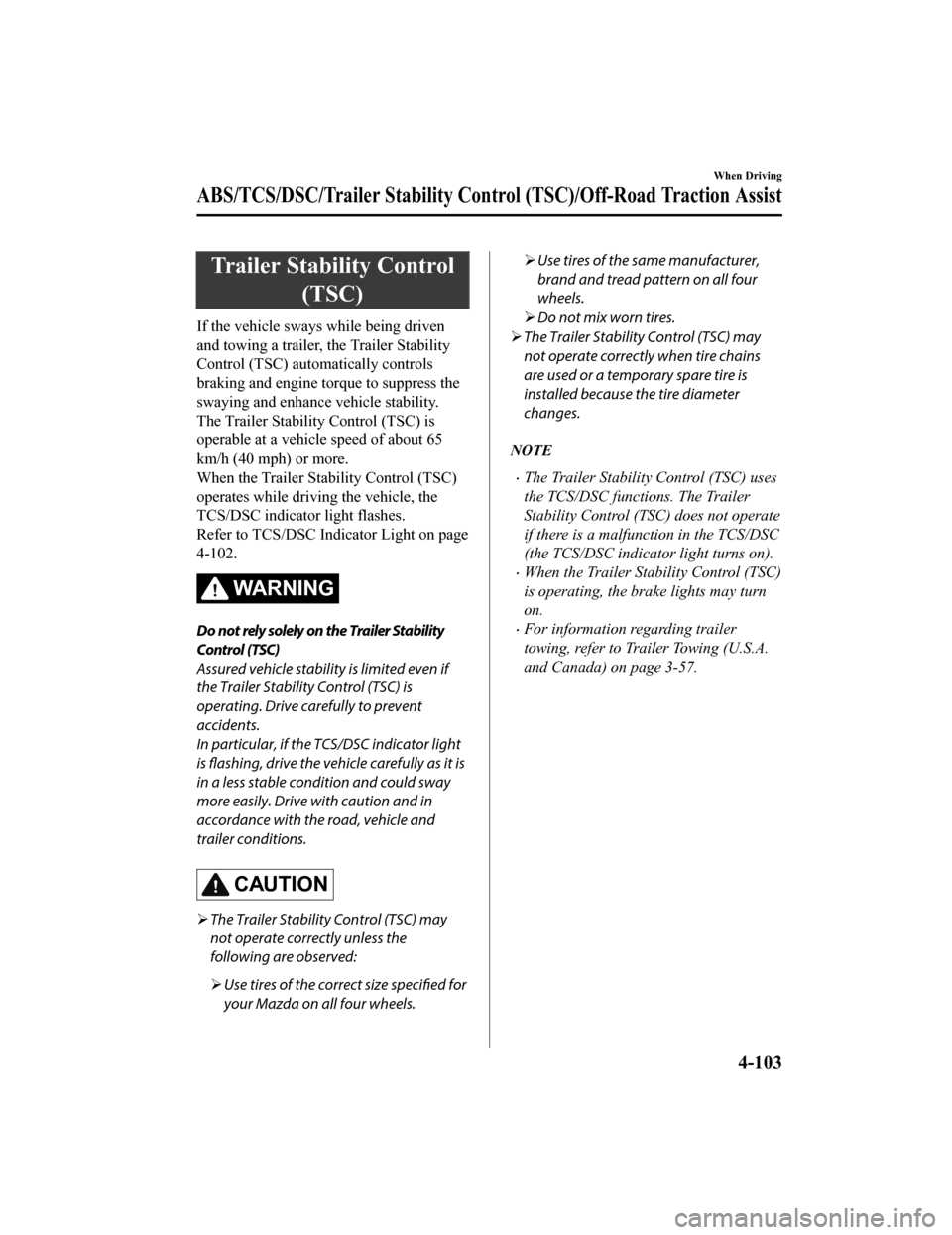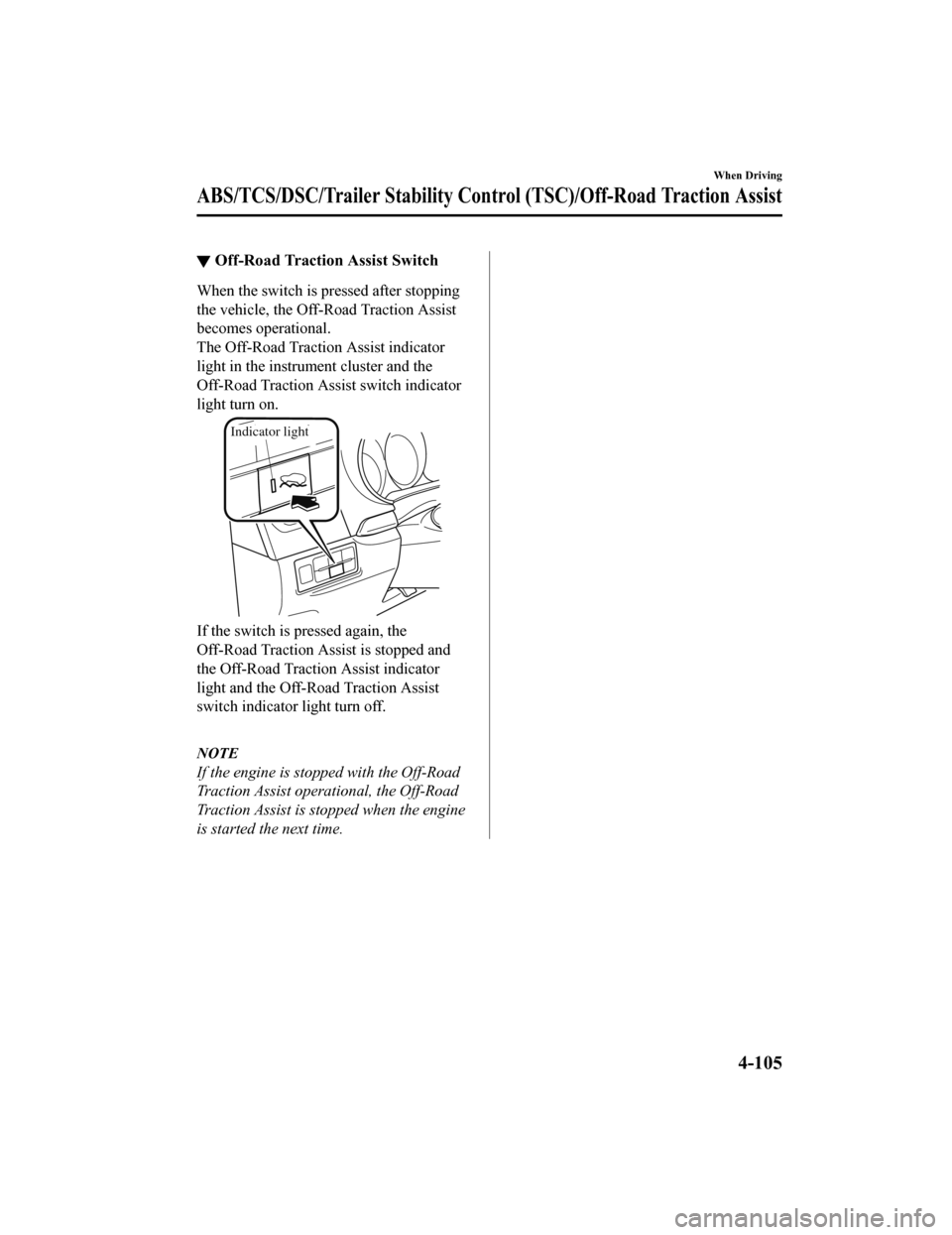traction control MAZDA MODEL CX-9 2020 (in English) User Guide
[x] Cancel search | Manufacturer: MAZDA, Model Year: 2020, Model line: MODEL CX-9, Model: MAZDA MODEL CX-9 2020Pages: 706
Page 269 of 706

Trailer Stability Control(TSC)
If the vehicle sways while being driven
and towing a trailer, the Trailer Stability
Control (TSC) auto matically controls
braking and engine torque to suppress the
swaying and enhance vehicle stability.
The Trailer Stability Control (TSC) is
operable at a vehicle speed of about 65
km/h (40 mph) or more.
When the Trailer Stab ility Control (TSC)
operates while driving the vehicle, the
TCS/DSC indicator light flashes.
Refer to TCS/DSC Indicator Light on page
4-102.
WA R N I N G
Do not rely solely on the Trailer Stability
Control (TSC)
Assured vehicle stability is limited even if
the Trailer Stability Control (TSC) is
operating. Drive carefully to prevent
accidents.
In particular, if the TCS/DSC indicator light
is flashing, drive the vehicle carefully as it is
in a less stable condition and could sway
more easily. Drive with caution and in
accordance with the road, vehicle and
trailer conditions.
CAUTION
’āś The Trailer Stability Control (TSC) may
not operate correctly unless the
following are observed:
’āś Use tires of the correct size
specified for
your Mazda on all four wheels.
’āś Use tires of the same manufacturer,
brand and tread pattern on all four
wheels.
’āś Do not mix worn tires.
’āś The Trailer Stability Control (TSC) may
not operate correctly when tire chains
are used or a temporary spare tire is
installed because the tire diameter
changes.
NOTE
’éĘThe Trailer Stability Control (TSC) uses
the TCS/DSC functions. The Trailer
Stability Control (TSC) does not operate
if there is a malfunction in the TCS/DSC
(the TCS/DSC indicator light turns on).
’éĘWhen the Trailer Stability Control (TSC)
is operating, the brake lights may turn
on.
’éĘFor information regarding trailer
towing, refer to Trailer Towing (U.S.A.
and Canada) on page 3-57.
When Driving
ABS/TCS/DSC/Trailer Stability Control (TSC)/Off-Road Traction Assist
4-103
CX-9_8HT8-EA-19I_Edition2_old 2019-9-24 13:14:55
Page 271 of 706

Ō¢╝Off-Road Traction Assist Switch
When the switch is pressed after stopping
the vehicle, the Off-Road Traction Assist
becomes operational.
The Off-Road Traction Assist indicator
light in the instrument cluster and the
Off-Road Traction Assist switch indicator
light turn on.
Indicator light
If the switch is pressed again, the
Off-Road Traction Assist is stopped and
the Off-Road Traction Assist indicator
light and the Off-Road Traction Assist
switch indicator light turn off.
NOTE
If the engine is stopped with the Off-Road
Traction Assist operational, the Off-Road
Traction Assist is stopped when the engine
is started the next time.
When Driving
ABS/TCS/DSC/Trailer Stability Control (TSC)/Off-Road Traction Assist
4-105
CX-9_8HT8-EA-19I_Edition2_old
2019-9-24 13:14:55
Page 551 of 706

Ō¢╝Tire Rotation
WA R N I N G
Rotate tires periodically:
Irregular tire wear is dangerous. To
equalize tread wear for maintaining good
performance in handling and braking,
rotate the tires every 12,000 km (7,500
miles). However Mazda recommends to
rotate every 8,000 km (5,000 miles) to help
increase tire life and distribute wear more
evenly.
Refer to Scheduled Maintenance on page
6-4.
During rotation, inspect them for correct
balance.
Do not include (TEMPORARY USE ONLY)
spare tire in rotation.Forward
Also, inspect them fo
r uneven wear and
damage. Abnormal wear is usually caused
by one or a combination of the following:
’éĘIncorrect tire pressure
’éĘImproper wheel alignment
’éĘOut-of-balance wheel
’éĘSevere braking
After rotation, inflate all tire pressures to
specification (page 9-7) and inspect the
lug nuts for tightness.
CAUTION
Rotate unidirectional tires and radial tires
that have an asymmetrical tread pattern or
studs only from front to rear, not from side
to side. Tire performance will be reduced if
rotated from side to side.
Ō¢╝ Replacing a Tire
WA R N I N G
Always use tires that are in good condition:
Driving with worn tires is dangerous.
Reduced braking, steering, and traction
could result in an accident.
Replace all four tires at the same time:
Replacing just one tire is dangerous. It
could cause poor handling and poor
braking resulting in loss of vehicle control.
Mazda strongly recommends that you
replace all four tires at the same time.
If a tire wears evenly, a wear indicator will
appear as a solid band across the tread.
Maintenance and Care
Owner Maintenance
6-39
CX-9_8HT8-EA-19I_Edition2_old
2019-9-24 13:14:55
Page 653 of 706

Uniform Tire Quality Grading System (UTQGS)
This information relates to the tire grading system developed by the U.S. National Highway
Traffic Safety Administration for grading t ires by tread wear, traction, and temperature
performance.
Ō¢╝ Tr e a d We a r
The tread wear grade is a comparative rating based on the wear rate of the tire when tested
under controlled conditions on a
specified government test course.
For example, a tire graded 150 would wear on e-and-a-half times as well on the government
course as a tire graded 100.
The relative performance of tires depends upon the actual conditions of their use, however,
and may depart significantly from the norm because of variations in driving habits, service
practices and differences in road characteristics and climate.
Ō¢╝ Traction-AA, A, B, C
The traction grades, from highest to lowest, are AA, A, B, and C. These grades represent the
tire's ability to stop on wet pavement as meas
ured under controlled conditions on specified
government test surfaces of asphalt and conc rete. A tire marked C may have poor traction
performance.
WA R N I N G
The traction grade assigned to this tire is based on braking (straight ahead) traction tests and
does not include acceleration cornering (turning), hydroplaning, or peak traction
characteristics.
Ō¢╝ Te m p e r a t u r e - A , B , C
The temperature grades A (the highest), B, and C, represent the tire's resistance to the
generation of heat and its abili
ty to dissipate heat when tested under controlled conditions
on a specified indoor laboratory test wheel.
Sustained high temperature can cause the material of the tire to degenerate and reduce tire
life, and excessive temperatures can lead to sudden tire failure.
Grade C corresponds to a level of performance which all passenger vehicle tires must meet
under the Federal Motor Vehicle Safety Standard No. 109. Grades B and A represent higher
levels of performance on the laboratory test wheel than the minimum required by law.
Customer Information and Reporting Safety Defects
Uniform Tire Quality Grading System (UTQGS)
8-23
CX-9_8HT8-EA-19I_Edition2_old 2019-9-24 13:14:55
Page 657 of 706

Letter RatingSpeed Rating
V1 49 m ph
W 168
* mph
Y 186
* mph
* For tires with a maximum speed capability over 149 mph, tire manufacturers sometimes use the letters ZR. For
tires with a maximum speed capability over 186 mph, tire manufacturers always use the letters ZR.
MS or M/S: Mud and Snow
AT: All Terrain.
AS: All Season. The ŌĆ£M
SŌĆØ or ŌĆ£M/SŌĆØ indicates that the tire has some functional use in mud
and snow.
U.S. DOT Tire Identification Number (TIN)
This begins with the letters ŌĆ£DOTŌĆØ which indicates the tire meets all federal standards. The
next two numbers or letters are the plant code where it was manufactured, and the last four
numbers represent the week and year the tire was manufactured. For example, the numbers
457 means the 45st week of 1997. After 2000 the numbers go to four digits. For example,
the number 2102 means the 21th week of 2002. The other numbers are marketing codes
used at the manufacturer's discretion. This information is used to contact consumers if a tire
defect requires a recall.
Tire Ply Composition and Materials Used
The number of plies indicates the number of layers of rubber-coated fabric in the tire. In
general, the greater the number of plies, the more weight a tire can support. Tire
manufacturers also must indicate the tire mate rials, which include steel, nylon, polyester,
and other.
Maximum Load Rating
This number indicates the maximum load in kilograms and pounds that can be carried by the
tire.
Maximum Permissible Inflation Pressure
This number is the greatest amount of air pressure that should ever be put in the tire under
normal driving conditions.
Tread Wear, Traction and Temperature Grades
Tr e a d w e a r : The tread wear grade is a comparative rating based on the wear rate of the tire
when tested under controlled conditions on a specified government test course. For
example, a tire graded 150 would wear one and one-half (1 1/2) times as well on the
government course as a tire graded 100.
Customer Information and Reporting Safety Defects
Tire Information (U.S.A.)
8-27
CX-9_8HT8-EA-19I_Edition2_old 2019-9-24 13:14:55
Page 658 of 706

Traction: The traction grades, from highest to lowest are AA, A, B, and C. The grades
represent the tire's ability to stop on wet pave ment as measured under controlled conditions
on specified government test surfaces of asphalt and concrete. A tire marked C may have
poor traction performance.
Te m p e r a t u r e : The temperature grades are A (the highest), B and C, representing the tire's
resistance to the generation of heat and its ability to dissipate heat when tested under
controlled conditions on a specif ied indoor laboratory test wheel.
Snow Tires
In some heavy snow areas, local governments may require true snow tires, those with very
deeply cut tread. These tires should only be used in pairs or placed on all four wheels. Make
sure you purchase snow tires that are the same size and construction type as the other tires
on your vehicle.
SAFETY WARNING
The following safety warning appears on the tire's sidewall.
SERIOUS INJURY MAY RESULT FROM:
’éĘEXPLOSION OF TIRE/RIM ASSEMBLY DUE TO IMPROPER MOUNTING-MATCH
TIRE DIAMETER TO RIM DIAMETER; NEVE R EXCEED 40 psi (275 kPa) TO SEAT
BEADS-ONLY SPECIALLY TRAINED PERSONS SHOULD MOUNT TIRES.
’éĘTIRE FAILURE DUE TO UNDER-INFLATION/OVERLOADING/
DAMAGE-FOLLOW OWNER'S MANUAL AND PLACARD IN
VEHICLE-FREQUENTLY CHECK INFLATION PRESSURE AND INSPECT FOR
DAMAGE.
Ō¢╝ Information on Temporary Tires
Please refer to the sample below.
Customer Information and Reporting Safety Defects
Tire Information (U.S.A.)
8-28
CX-9_8HT8-EA-19I_Edition2_old
2019-9-24 13:14:55
Page 703 of 706

Index
Key Left-in-trunk Warning Beep (With
the advanced keyless function)......... 7-49
Key Left-in-vehicle Warning Beep (With
the advanced keyless function)......... 7-49
Key Removed from Vehicle Warning
Beep...................................................7-48
Key Suspend Function........................ 3-9
L
Label Information............................... 9-2
Lane Departure Warning sound........ 7-51
Lane-change Signals......................... 4-74
Lane-keep Assist System (LAS) & Lane
Departure Warning System
(LDWS)........................................... 4-156
Leaving Home Light......................... 4-71
Liftgate.............................................. 3-20When Liftgate Cannot be
Opened......................................... 7-52
Lighting Control................................4-68
Lights-on Reminder.......................... 7-47
Light Bulbs Replacement................................ 6-42
Specifications.................................9-6
Lubricant Quality ................................ 9-4
Luggage Compartment....................5-106 Cargo Securing Loops............... 5-106
Cargo Sub-Compartment........... 5-106
Luggage Compartment Light............ 5-94
M
Maintenance
Information.................................... 6-2
Scheduled.......................................6-4
Maintenance Monitor........................ 6-15
Map Lights........................................ 5-94
Mazda Radar Cruise Control with Stop &
Go function (MRCC with Stop & Go
function).......................................... 4-141 Close proximity warning........... 4-145
Cruise control function.............. 4-153
Display indication......................4-143
Setting the system..................... 4-146
Stop hold control....................... 4-152
Message Indicated in Multi-information
Display.............................................. 7-45
Message Indicated on Display.......... 7-43
Meters................................................ 4-12
Mirrors Outside mirrors..... ....................... 3-34
Rearview mirror.......................... 3-36
Mirror Defogger......... ....................... 4-79
Moonroof...........................................3-42
Multi-information Display (Type
A).......................................................4-14
Multi-information Display (Type
B)....................................................... 4-31
Multi-information Display (Type
C)....................................................... 4-46
O
Off-Road Traction Assist
Off-Road Traction Assist indicator
light............................................ 4-104
Off-Road Traction Assist
switch......................................... 4-105
Outside Mirrors......... ........................ 3-34
Overhead Console........................... 5-104
Overhead Lights................................ 5-94
Overheating....................................... 7-23
Overloading....................................... 3-54
Owner Maintenance Closing the hood...... ................... 6-19
Engine compartment overview.... 6-21
Key battery replacemen t..............6-34
Opening the hood........................ 6-19
Owner maintenance
precautions................................... 6-17
10-7
CX-9_8HT8-EA-19I_Edition2_old 2019-9-24 13:14:55
Page 705 of 706

Index
Shopping Bag Hook........................ 5-107
Smart Brake Support (SBS)............ 4-173Collision warning...................... 4-174
Stopping the Smart Brake Support
(SBS) system operation............. 4-174
Smart City Brake Support
(SCBS)............................................ 4-170
Collision warning...................... 4-172
Smart City Brake Support (SCBS)
Indicator Light (Red).................4-172
Stopping the Smart City Brake
Support (SCBS) System
Operation................................... 4-172
Spare Tire............................................ 7-6
Specifications...................................... 9-4
SRS Air Bags Front passenger occupant
classification system.................... 2-84
How the SRS air bags work........ 2-77
Limitations to SRS air bag.......... 2-82
Monitoring................................... 2-88
SRS air bag deployment
criteria.......................................... 2-81
Supplemental restraint system
components.................................. 2-75
Starting the Engine..............................4-6
Steering Wheel Heated steering wh eel................. 2-34
Horn............................................. 4-80
Storage Box..................................... 5-105
Storage Compartments.................... 5-104
Armrest box............................... 5-105
Center console........................... 5-104
Glove compartment................... 5-104
Luggage Compartment.............. 5-106
Overhead console...................... 5-104
Rear coat hooks......................... 5-108
Shopping bag hook....................5-107
Storage Box............................... 5-105
Sunshade............................................3-44
Sunshade (Rear door window)........ 5-108Sunvisors........................................... 5-93
T
Theft-Deterrent System ..................... 3-47
Third-Row Seat................................. 2-26
Three-flash Turn Sign al.................... 4-74
Tires................................................... 6-38 Flat tire.......................................... 7-3
Replacing a tire........................... 6-39
Replacing a wheel....................... 6-41
Snow tires.................................... 3-52
Specifications.................................9-7
Temporary spare tire....................6-40
Tire chains................................... 3-52
Tire inflation pressure................. 6-38
Tire rotation................................. 6-39
Uniform tire quality grading system
(UTQGS)..................................... 8-23
Tire Inflation Pressure Warning
Beep...................................................7-50
Tire Information................................ 8-25
Tire Pressure Monitoring System.... 4-217
To w i n g Hook............................................ 7-26
Recreational towing.....................3-65
Trailer towing (U.S.A. and
Canada)........................................ 3-57
Towing Description........................... 7-25
Traction Control System (TCS)...... 4-100 TCS OFF Indicator Light.......... 4-101
TCS OFF Switch....................... 4-101
TCS/DSC indicator light........... 4-100
Traffic Sign Recognition System
(TSR)............................................... 4-127
Trailer Stability Control (TSC)....... 4-103
Transmitter.......................................... 3-5
Trouble Battery runs out........................... 7-19
Emergency starting...................... 7-22
Emergency towing....................... 7-25
10-9
CX-9_8HT8-EA-19I_Edition2_old 2019-9-24 13:14:55